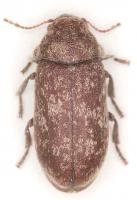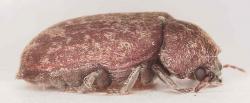Adult
Size
5 to 8 mm long.
Aspect
Oval, elongate, sturdy. Big, wide thorax that partly covers the head.
Fairly short antennae composed of 11 articles; the last 3 articles form a barely developed club.
Dorsal faces of thorax and elytra are finely grainy, with irregular tufts of short, bent, golden bristles that give them a characteristic mottled aspect.
Colour
Reddish brown


 Grande vrillette ; Vrillette marquetée ; Vrillette damier ; Horloge de la mort
Grande vrillette ; Vrillette marquetée ; Vrillette damier ; Horloge de la mort  Death watch beetle
Death watch beetle  El escarabajo del reloj de la muerte
El escarabajo del reloj de la muerte  Der bunte Klopfkäfer ; Gescheckte Nagekäfer ; Bunte Pochkäfer
Der bunte Klopfkäfer ; Gescheckte Nagekäfer ; Bunte Pochkäfer 

